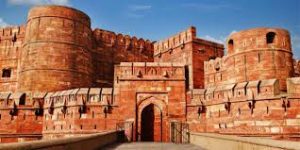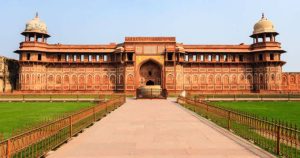Digital News Guru History Desk:
Agra Fort, an iconic symbol of India’s rich history, is located in the heart of the city of Agra in Uttar Pradesh. A UNESCO World Heritage site since 1983, it is not just an architectural marvel, but also a living testament to the grandeur of the Mughal Empire. Built by Emperor Akbar in the 16th century, the fort has witnessed numerous transformations, battles, and royal intrigue. It stands as a reminder of the imperial power that once ruled much of the Indian subcontinent.
Historical Background
The story of Agra Fort begins with the Mughal emperor Akbar, who ascended to the throne in 1556. The fort was initially constructed on the site of an old military establishment, which dates back to the 11th century. The original structure was a simple mud fort, but Akbar envisioned a grand, imposing fort that would reflect the might of the Mughal dynasty. He commissioned the transformation of this fort into a grand stone structure, a project that was completed by the end of the 16th century.

Akbar’s vision for the fort was not just as a military stronghold but as a symbol of his empire’s power. The fort became a seat of governance, where the emperor and his courtiers conducted their political and military affairs. The fort also served as a residence for the emperor, and its design incorporated elements of Persian, Timurid, and Indian architecture, blending these influences to create a unique architectural style.
Architectural Features
Agra Fort covers an area of approximately 94 acres and is surrounded by a 70-foot-high defensive wall. The fort’s design is heavily influenced by Persian and Mughal architecture, which is evident in its intricate carvings, stunning arches, and large courtyards. The fort is made primarily of red sandstone, which gives it its characteristic color.
- Jahangir Mahal: One of the most significant structures within Agra Fort is the Jahangir Mahal, a magnificent palace that was built by Akbar for his beloved wife, Mariam-uz-Zamani. This architectural wonder boasts a mix of Hindu and Persian styles, with ornate arches, intricate latticework, and beautiful courtyards. The palace’s grand structure and elegant carvings make it one of the fort’s most famous buildings.
- Diwan-i-Aam (Hall of Public Audiences): The Diwan-i-Aam is a large open courtyard with a raised platform where the emperor would address the common people. This hall is famous for its beautiful design and ornate pillars. The emperor would listen to petitions, disputes, and public grievances here, a testament to the Mughal tradition of administrative engagement with the masses.
- Diwan-i-Khas (Hall of Private Audiences): This hall, made of white marble, was used by the emperor to hold private discussions with his ministers, nobility, and foreign dignitaries. The central feature of this hall is the elegant marble throne where the emperor would sit during important meetings. The intricate stonework and designs on the walls of the Diwan-i-Khas reflect the artistic excellence of the Mughal era.
- Musamman Burj: Perhaps the most famous part of the fort, Musamman Burj, holds great historical significance. This octagonal tower overlooks the Yamuna River and is believed to be the place where Emperor Shah Jahan, the builder of the Taj Mahal, was imprisoned by his son Aurangzeb. Shah Jahan spent his last years in this tower, gazing at the Taj Mahal, the monument he built in memory of his wife Mumtaz Mahal. The Musamman Burj is an exquisite piece of Mughal architecture, with its marble inlay work and beautiful surroundings.
- The Moti Masjid (Pearl Mosque): Another gem inside Agra Fort is the Moti Masjid, built by Emperor Shah Jahan. Made of pure white marble, the mosque is one of the finest examples of Mughal religious architecture. It was constructed for the private use of the emperor and his court, and its simplicity and elegance contrast with the grandeur of other structures in the fort.
Agra Fort’s Strategic Importance
Agra Fort was strategically located on the banks of the Yamuna River, making it a formidable military stronghold. The fort’s imposing walls and robust gates were designed to withstand attacks from any direction. Over the centuries, it played a pivotal role in several key historical events, including the defense of the Mughal Empire and the expansion of its territories.
In the 17th century, the fort became the center of political power in India, housing the Mughal emperors and their court. The fort’s significance continued to grow until the decline of the Mughal Empire when it fell into disrepair. During the British colonial period, the fort was used as a military garrison, further altering its historical context.
The Fort’s Decline and Restoration
The decline of the Mughal Empire had a profound effect on Agra Fort. In the 18th century, after the fall of the Mughal dynasty, the fort was abandoned, and many of its structures were left in ruins. However, during British rule, the fort was partially restored and converted into a military garrison. The British also made several changes to the fort’s architecture to suit their military needs.
Post-independence, Agra Fort became a popular tourist destination and was designated as a UNESCO World Heritage site. Efforts have been made to preserve and protect the fort, ensuring that it remains a significant historical monument. Today, it attracts millions of tourists annually, eager to explore its majestic structures and learn about India’s rich Mughal history.
Cultural and Historical Significance
Agra Fort is not just a monument; it is a reflection of the grandeur of Mughal rule. Its architectural beauty, strategic significance, and rich history make it one of the most important cultural and historical sites in India. The fort’s story is intricately linked with that of the Mughal emperors, and it continues to serve as a symbol of India’s cultural heritage.

The fort’s importance is also highlighted by its proximity to the Taj Mahal, just across the river, and the fact that both sites are often visited together by tourists exploring the history of the Mughal Empire.
Conclusion
Agra Fort remains an enduring symbol of Mughal architecture and an important part of India’s history. From its origins as a military stronghold to its transformation into a royal palace, the fort has been at the center of many historical events. Today, it stands as a UNESCO World Heritage site, drawing visitors from all over the world who come to marvel at its beauty, explore its history, and appreciate its architectural brilliance.
You May Also Read: The Role and Functioning of the Securities and Exchange Board of India (SEBI)









